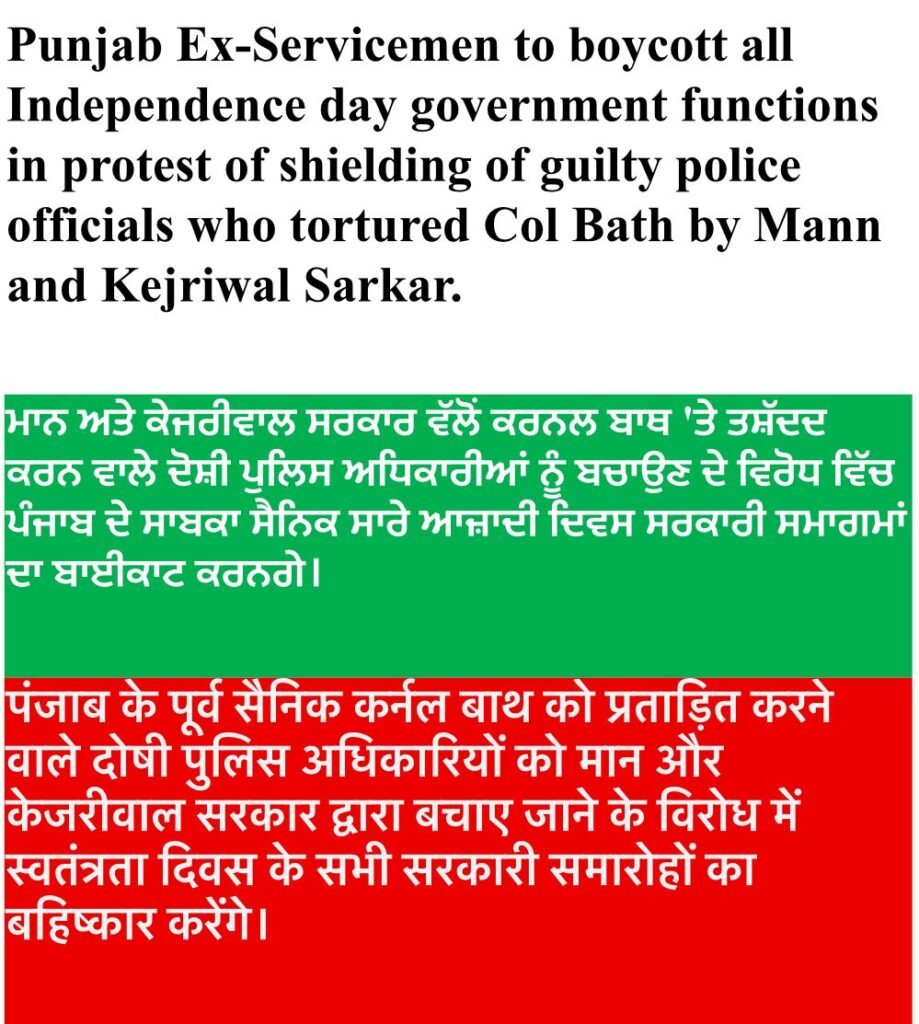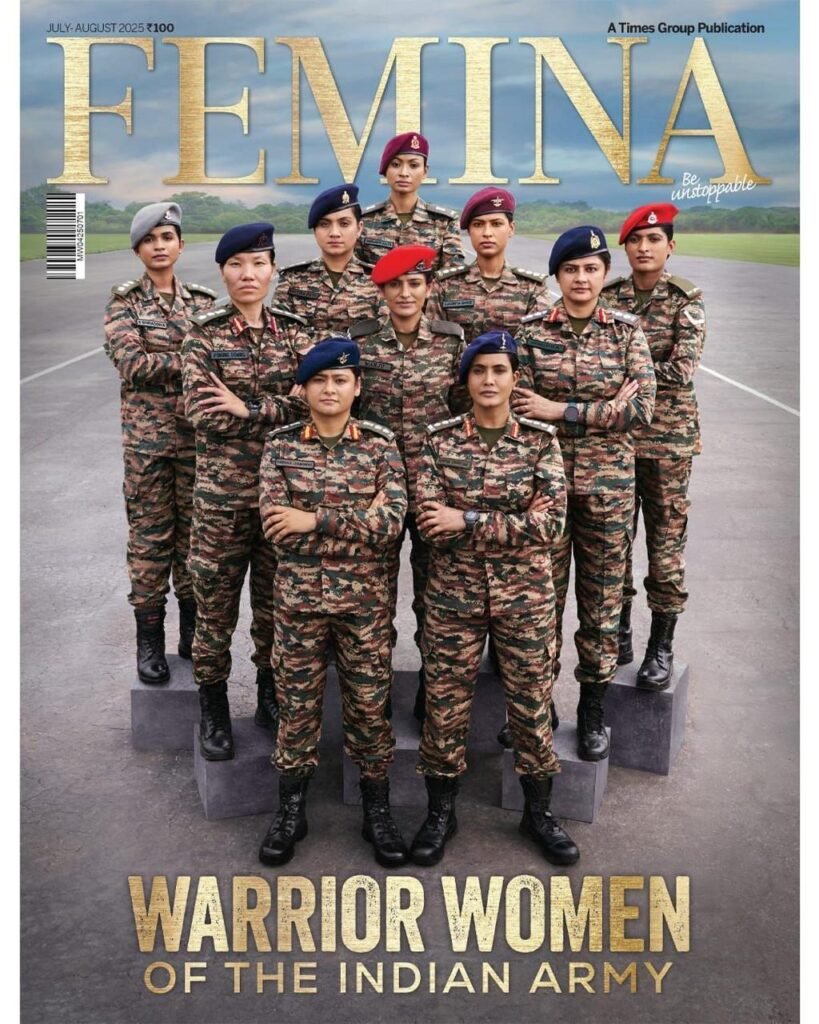Category Archives: Uncategorized
Sanjha Morcha Calls all Ex=Servicemen 0f Punjab to boycott Punjab Govt Independence day Functions


Punjab soldier’s wife mourns, her hands still adorning mehndi, arms with wedding bangles move many to tears
Khanna’s Lance Naik Pritpal Singh was killed during an anti-terrorist operation in the dense forests of Kulgam, Jammu and Kashmir
Nikhil Bhardwaj Tribune News Service

Army soldier Lance Naik Pritpal Singh was killed during an anti-terrorist operation in the dense forests of Kulgam, Jammu and Kashmir, on Friday night. Another soldier who was killed has bene identified as Sepoy Harminder Singh from Badinpur (Mandi Gobindgarh).
The operation has been ongoing since August 1. His family in Khanna’s Manupur village was informed at 5 am on Saturday.
The devastating news shattered the household, especially his wife Manpreet Kaur, who had married Pritpal just six months ago on February 26.
The sight of her hands still adorned with mehndi and arms with wedding bangles moved many to tears.
Pritpal joined the Indian Army in 2015, right after completing his Class 12. He is survived by his elderly parents, wife, and two brothers, Manpreet and Harpreet Singh. The family said they were dependent on him financially and emotionally.
His brother shared that their last conversation was on Friday, during which Pritpal spoke of the intense encounter with terrorists and expressed hope that the Army would eliminate them soon.
“He was supposed to come home later this month. We had planned to celebrate our first Diwali together,” his wife said in tears.
The cremation is expected to be held in Manupur village on Sunday. The entire village and nearby regions are mourning the loss of a braveheart who gave his life for the nation.
Punjab Chief Minister Bhagwant Mann has announced an ex-gratia of Rs 1 crore each for the families of two soldiers from the state—Lance Naik Pritpal Singh from Manupur (Khanna) and Sepoy Harminder Singh from Badinpur (Mandi Gobindgarh)—who were martyred.
Taking to social media, CM Mann expressed deep grief and saluted the bravery of the soldiers who laid down their lives in the line of duty.
The Indian Army’s Chinar Corps also paid tribute, stating that the courage and dedication of the bravehearts will continue to inspire generations.
The joint operation in Kulgam, involving the Army, CRPF, J&K Police, and SOG, is still ongoing, with one terrorist neutralised so far.
Khanna soldier martyred in Kulgam, pall of gloom descends on village
Nikhil Bhardwaj ribune News Service

Pall of gloom descended on Manupur village, in Khanna as an Indian Army soldier, Lance Naik Pritpal Singh, was martyred on Friday night during an anti-terrorist operation in the dense forests of Kulgam, Jammu and Kashmir. The operation has been ongoing since August 1.
The family was informed of the death by the Army at around 5 am on Saturday morning and was left in deep shock. The 29-year-old martyred soldier joined the Army in 2015. He had been married for only six months and leaves behind his elderly parents and wife, Manpreet Kaur. His uncle and aunt also retired from the military.
After hearing the news of her husband’s demise, Manpreet was left inconsolable. Everyone burst into tears seeing her hands still adorned with the customary wedding bangles and mehendi for the festive season. His father, while mourning the immense loss, said,” I salute my son’s martyrdom for the country. My son will never return now, but he sacrificed his life for nation.”
Pritpal Singh’s elder brother, Manpreet Singh, while talking to mediapersons, said they last spoke to him on Friday and Pritpal had apprised them of the ongoing shootout with the terrorists. “He had told us that the Indian Army would soon eliminate the terrorists,” he said.
Pritpal’s wife shared that Pritpal was supposed to come home at the end of the month as they had planned to celebrate all the upcoming festivals together, including their first Diwali as a married couple, but those dreams were left shattered.
Pritpal’s brother Harpreet Singh said they were three brothers. The whole family was dependent on Pritpal. “My brother had joined the Army as soon as he passed class XII in 2015. We had told him that it is Rakhi and that he should come home to celebrate but he had said he will come on Diwali,” he said, adding that, “I am proud of my brother. He sacrificed his life for the country. The Indian Army should eliminate the terrorists.”
Pritpal Singh’s cremation is expected to be performed at Manupur village on Sunday.
2 Punjab soldiers killed in Kulgam encounter
Operation completes 9 days; CM Mann announces Rs 1 crore ex gratia each

Two Army men were killed and two others injured in an encounter with terrorists in south Kashmir’s Kulgam district, the ongoing operation entering its ninth day on Saturday and being one of the longest in Jammu and Kashmir in recent years.
The martyrs belonged to Punjab and have been identified as Lance Naik Pritpal Singh of Manupur village in Khanna and Sepoy Harminder Singh of Badinpur village in Mandi Gobindgarh.
Punjab Chief Minister Bhagwant Mann expressed grief over the deaths and announced an honorarium of Rs 1 crore each to the families of the deceased soldiers. “We salute the spirit and bravery of the martyrs. As per our government’s promise, an honorarium of Rs 1 crore each will be provided to their families,” CM Mann posted on X. J&K Chief Minister Omar Abdullah visited the Chinar Corps headquarters at Badamibagh in Srinagar and laid a wreath in the honour of the martyred soldiers. The anti-terror operation started last week in a dense forest of Akhal. Eight Army personnel have so far been injured, with the security forces making all-out efforts to eliminate the hiding terrorists, who appear to be highly trained and well-equipped. The area has been experiencing heavy firing for several days, including during night hours.
Of late, militants have shifted their bases to jungles and high-altitude areas due to the heavy deployment of security forces in various parts of J&K in the aftermath of the Pahalgam terror attack in which 26 civilians were killed.
The body of one militant has been retrieved from the gunfight site while another terrorist is also believed to have been killed. Intelligence inputs had suggested that at least five militants were holed up in the forest when the operation started.
With the operation getting prolonged, top security officials, including J&K Director General of Police Nalin Prabhat and General Officer Commanding of the 15 Corps, Lt Gen Prashant Srivastava, have visited the site. The Army has deployed elite commandos and is taking the assistance of drones and helicopters to locate the militants.
Army’s Srinagar-based Chinar Corps wrote on X, “Chinar Corps honours the supreme sacrifice of the bravehearts. Their courage and dedication will forever inspire us. The Army expresses deepest condolences and stands in solidarity with the bereaved families.”
Army’s Northern Commander Lt Gen Pratik Sharma also paid homage to the martyrs. “The Northern Command stands firm with the bereaved families in this hour of grief,” the Army said.
Femina Highlight the brave ladies of Army

Army proud of ladies in Indian Army: femina
7 Ladies in Army known for their Bravery and beauty
TO GET CSD CARDS, NOW YOU CAN APPLY ONLINE AND GET CARD DELIVERED AT YOUR HOME.
PROCEDURE:
1) Online Website for CSD Smart Card:- https://csdsmartcard.co.in
2) Fill up Online Form.
3) Make online payment.
4) CSD Cards will be delivered within 7-20 days by courier service directly at your home address.
5) You can track your online application also.
NOW NO NEED TO VISIT ANY CSD CANTEEN OFFICE TO GET FORM AND APPLY FOR CSD CARDS.
ALL WHO ARE APPLYING FOR FIRST TIME OR RE-APPLYING, ARE REQUIRED TO APPLY ONLINE ONLY.
CSD CARDS ARE VALID FOR 10 YEARS. EXPIRY DATE IS WRITTEN IN YOUR CSD CARDS, PURCHASE BILLS AND ALSO CSD BILLING CLERK CAN TELL YOU.
MoD seeks 200 copters to replace ageing fleet
the Army and the IAF together have a requirement of over 450 light helicopters, with the former requiring around 250 of them.
Ajay Banerjee Tribune News Service

The Ministry of Defence (MoD) is looking at getting 200 helicopters for the Army and the Indian Air Force, which will replace the six-decade-old Cheetah and Chetak copters.
The MoD on Friday issued a request for information (RFI) – the first step in the tendering process. The plan is to buy 120 of these reconnaissance and surveillance helicopters for the aviation corps of the Army while the remaining 80 for the IAF.
This RFI, allows helicopters manufacturers to partner with Indian companies and bid for the project, but the copter will need to be made in India.
The MoD aims to identify probable vendors, including an Indian company, that will form a joint venture with the original equipment manufacturer, that could be an Indian or a foreign company. A meeting with the vendors is scheduled in a month.
Crucially, the MoD has not restricted its search to single engine copters and is open to twin-engined ones too. The copters should be able to perform the following roles by day and night, do reconnaissance and surveillance, carry a small body of troops or quick reaction teams for special missions; carry internal and external loads in support of ground operations, do scouting duties in conjunction with attack helicopters.
Since the usage will be in extreme climates like the hot deserts or the perma-frost of Siachen, the MoD has asked for specific load carrying capacities when operating in Siachen or areas above 16,000 feet altitude. So far, the Army and IAF use the single-engine Cheetah and Chetak copters and also the twin-engined advanced light helicopters (ALH) in the mountains.
The Chetak is based on the French designed Aérospatiale Alouette III and was inducted in 1962 and Hindustan Aeronautics Limited began manufacturing them under licence in 1965. The Cheetah is derived from the Aérospatiale SA 315B Lama and entered service in 1976.
A demand to retire the ageing choppers has gained traction in recent years in the wake of a string of accidents, including several fatal ones.
Of the 246 Cheetah/Chetak helicopters, the Indian Army Aviation Corps currently operates around 190 choppers, of which nearly 30 are in maintenance. While the Army and the IAF together have a requirement of over 450 light helicopters, the Army will need around 250 of them.
The Army is also looking at buying 80 indigenous light utility helicopters from HAL, however, the delivery is delayed because of some technical issues with the aircraft’s autopilot system. The LUH completed the high-altitude trials in 2020 and received the initial operational clearance in 2021.




























































